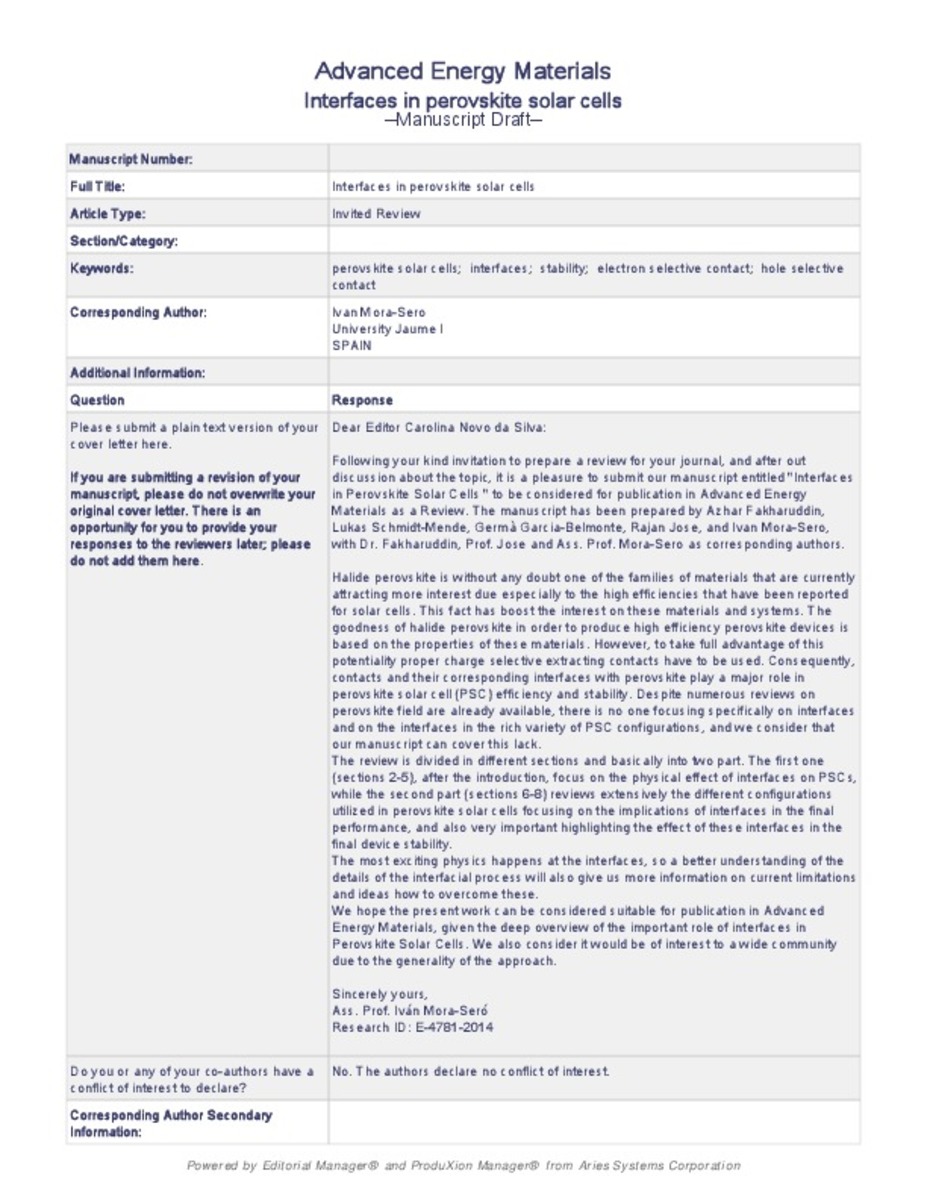Mostrar el registro sencillo del ítem
Interfaces in Perovskite Solar Cells
| dc.contributor.author | Fakharuddin, Azhar | |
| dc.contributor.author | Schmidt-Mende, Lukas | |
| dc.contributor.author | Garcia-Belmonte, Germà | |
| dc.contributor.author | Jose, Rajan | |
| dc.contributor.author | Mora-Sero, Ivan | |
| dc.date.accessioned | 2018-03-02T10:47:08Z | |
| dc.date.available | 2018-03-02T10:47:08Z | |
| dc.date.issued | 2017-11-22 | |
| dc.identifier.citation | FAKHARUDDIN, Azhar, et al. Interfaces in perovskite solar cells. Advanced Energy Materials, 2017, vol. 7, no 22. | ca_CA |
| dc.identifier.issn | 1614-6832 | |
| dc.identifier.issn | 1614-6840 | |
| dc.identifier.uri | http://hdl.handle.net/10234/173141 | |
| dc.description.abstract | Rapid improvement in photoconversion efficiency (PCE) of solution processable organometallic hybrid halide based perovskite solar cells (PSCs) have taken the photovoltaic (PV) community with a surprise and has extended their application in other electronic devices such as light emitting diodes, photo detectors and batteries. Together with efforts to push the PCE of PSCs to record values >22% – now at par with that of crystalline silicon solar cells – origin of their PV action and underlying physical processes are also deeply investigated worldwide in diverse device configurations. A typical PSC consists of a perovskite film sandwiched between an electron and a hole selective contact thereby creating ESC/perovskite and perovskite/HSC interfaces, respectively. The selective contacts and their interfaces determine properties of perovskite layer and also control the performance, origin of PV action, open circuit voltage, device stability, and hysteresis in PSCs. Herein, we define ideal charge selective contacts, and provide an overview on how the choice of interfacing materials impacts charge accumulation, transport, transfer/recombination, band-alignment, and electrical stability in PSCs. We then discuss device related considerations such as morphology of the selective contacts (planar or mesoporous), energetics and electrical properties (insulating and conducting), and its chemical properties (organic vs inorganic). Finally, the outlook highlights key challenges and future directions for a commercially viable perovskite based PV technology. | ca_CA |
| dc.format.extent | 44 p. | ca_CA |
| dc.format.mimetype | application/pdf | ca_CA |
| dc.language.iso | eng | ca_CA |
| dc.publisher | Wiley | ca_CA |
| dc.relation.isPartOf | Advanced Energy Materials, 2017, vol. 7, no 22 | ca_CA |
| dc.rights | Copyright © John Wiley & Sons, Inc. All Rights Reserved | ca_CA |
| dc.rights.uri | http://rightsstatements.org/vocab/InC/1.0/ | * |
| dc.subject | renewable energy | ca_CA |
| dc.subject | interfacial charge transfer | ca_CA |
| dc.subject | interface modification | ca_CA |
| dc.subject | interfacial defects in perovskite solar cells | ca_CA |
| dc.subject | hysteresis in perovskites | ca_CA |
| dc.title | Interfaces in Perovskite Solar Cells | ca_CA |
| dc.type | info:eu-repo/semantics/article | ca_CA |
| dc.identifier.doi | http://dx.doi.org/10.1002/aenm.201700623 | |
| dc.relation.projectID | Alexander von Humboldt Foundation; Ministry of Education (KPT), Govt. of Malaysia / RDU140126; Generalitat Valenciana / PROMETEOII/2014/020; MINECO of Spain Government / MAT2016-76892-C3-1-R | ca_CA |
| dc.rights.accessRights | info:eu-repo/semantics/openAccess | ca_CA |
| dc.relation.publisherVersion | http://onlinelibrary.wiley.com/doi/10.1002/aenm.201700623/full | ca_CA |
| dc.type.version | info:eu-repo/semantics/submittedVersion | ca_CA |
Ficheros en el ítem
Este ítem aparece en la(s) siguiente(s) colección(ones)
-
INAM_Articles [506]







